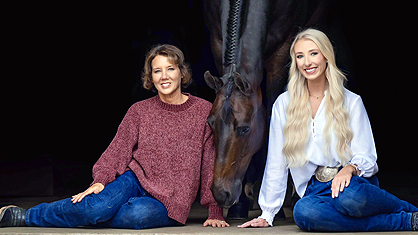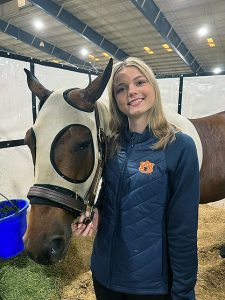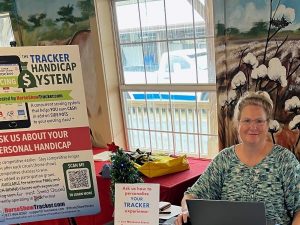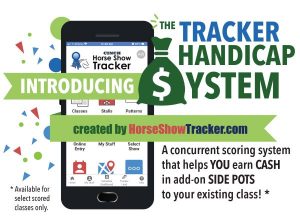The Horse Show Tracker Handicap System Simplified
“Win money sooner. Keep winning longer.”
By Delores Kuhlwein
Even though the word handicap has been used in various ways throughout history, in golf, a handicap or index is a numerical score that represents or measures the player’s ability.
“A golf handicap represents the number of strokes a player is expected to take above or below the course’s par score (par is the number of strokes an expert would be expected to take on that course).
The higher the handicap, the more strokes a player is allowed to subtract from their actual score to determine their net score. A lower handicap indicates a more skilled golfer who is expected to have a lower net score,” according to Stix Golf.
So if one relates that to a Trail exhibitor instead of a golfer, an inexperienced exhibitor will have a higher handicap than a very experienced, World Champion Trail exhibitor.
And as in golf, it can be fun to improve your own score against your past scores and therefore lower your handicap while earning some cash from a side pot.
Meet Ray and Kathy Trask, inventors of the Horse Show Tracker Handicap System (and yes, Horse Show Tracker). They explain their newly released scoring system, loosely based on the way a golf handicap system works in sporting events, gives everyone who participates a competitive chance to win based on their abilities.
Read on to see what both these brilliant entrepreneurs who happen to be familiar faces at the horse shows have to say:

UR Ride Has Arrived shown by Jennifer Paul won first place for owner Emma Brown in the Sr Trail Handicap class of 10 entries at Florida Gold Coast!
Which scored classes will be offered for the Tracker Handicap System at Sun Circuit?
Trail, Ranch Riding, Western Riding, Showmanship and Horsemanship – last year, we offered only Trail and Ranch Riding. We can support any scored class with enough stable statistics.
How do exhibitors enter?
You must enter online. It’s just like betting software, all done on the side and not through the show office. It’s an add-on and it runs concurrently with the existing class. It’s currently available to most horses in the majority of scored classes, our Handicap System is live and ready for online entries. You have until midnight before the class runs to enter online.
Where does the side pot money come from?
It’s typically a $50 entry fee, and 75% goes directly back to the pot. We’re using the NSBA payout model right now and we’re looking for feedback from exhibitors on whether the NSBA payout model is desirable.
How do you come up with “par” or the average for a pattern or class?
To make the math easy, we use 70 as “par.”

Libby Wilhelm and Moonlightin won first place under both sets of judges with a -8 handicap – winning $135💰in the first showmanship handicap class ever at Florida Gold Coast.
How do you come up with the horse’s handicap for that event/level?
We calculate handicaps for horses based on their past performances in scored classes at HST-scored class supported shows using a proprietary statistical analysis. A horse may have an “ND” (Need Data) handicap value if HorseShowTracker needs more statistics from HST-supported shows to calculate a handicap.
We went back over 8-10 years of scores to fine tune the system.
Your horse’s handicap will change every circuit – it keys off horse/division/discipline. We spent almost 5 years working on this system. We started with the math to use a more complex team roping system and ranch sorting approach, but decided to simplify and use a golf handicap-like system instead.
The handicaps are given out by division – the same horse will have different handicap in open than it does in amateur. When you view every class that has handicapping in it on the Horse Show Tracker, you can see what your handicap is and decide whether your horse can take advantage of it.
Is the handicapping more accurate for a horse and its rider over time as you continue to build their data?
You’ll notice we won’t assign anybody a handicap until it’s statistically stable. Over time, it stabilizes even further. It also becomes a rating system – you can look at the handicaps and see what you’re competing against.
How do you determine the payouts and scoring?
Final places in HST Handicap™ classes are calculated by adding the average judged scores to the entry’s handicap value at the time of the run.
For example an entry’s final handicap score of:
73.73 (Handicap score) = 72.50 (Average Judged Score) + 1.23 (HST Handicap)
High and low judges’ scores are dropped when there are four or more judges. In classes that are scored-then-ranked, the score will be used to award handicap payouts.

The system is entered separately from the show (online, like betting software), and Kathy Trask is pictured here answering questions of exhibitors at Gold and Gulf Coast shows.
Besides the fun and challenge of competing against yourself to see what happens to your score (and your possible side pot), why did you spend so much time creating this?
The Tracker Handicap System is designed in such a way that every competitor competes more against themselves than everyone else in the field. If a horse entry beats their own handicap, that is a good thing.
It’s less about you having to compete with Brent Maxwell today and more about you competing against your best score. We originally designed it for the middle to the lower guys to have better shots, but we found out that having a negative handicap does not go against you statistically as much as you think. It also benefits the upper level and makes it fun for them, too.
We wanted to keep the excitement and encourage people to stay in classes and get a little bit of cash at the end of the day. The idea was to help all people and horses in the industry, and to support horses to “Win money sooner. Keep winning longer.”
We have to ask – like any system where people can win money, can you game or cheat the system?
We spent a lot of time designing it so couldn’t be gamed. We think we have an advantage being a proprietary system – we change the horse’s handicap and potentially the system calculations from circuit to circuit so people can’t game the system.
What else do you want exhibitors to know?
The goal of our first year is to get people to understand and enjoy the side pots and have them start thinking about strategizing more. Later we can add team side pots, or even barn side pots – it could be fun to go barn against barn.
For now, we’re leaning toward the bigger circuits, but the possibilities are endless – for a smaller show, this could interest entry level exhibitors to get more active in their clubs. We are also looking for feedback on whether the NSBA payout model is desirable.
For more information, go to the help section of Horse Show Tracker and it has everything in there, along with FAQs.
https://www.horseshowtracker.com/event-items/Help
Download the rules: HandicapAgreementRules
Download the Sun Circuit flyer: HorseShowTrackerHandicapSystem











